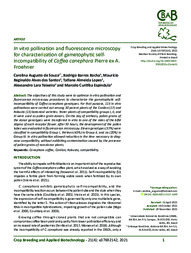In vitro pollination and fluorescence microscopy for characterization of gametophytic selfincompatibility of Coffea canephora Pierre ex A. Froehner.
In vitro pollination and fluorescence microscopy for characterization of gametophytic selfincompatibility of Coffea canephora Pierre ex A. Froehner.
Author(s): SOUZA, C. A. de; ROCHA, R. B.; SANTOS, M. R. A. dos; LOPES, T. A.; TEIXEIRA, A. L.; ESPINDULA, M. C.
Summary: The objectives of this study were to optimize in vitro pollination and fluorescence microscopy procedures to characterize the gametophytic selfincompatibility of Coffea canephora genotypes. For that purpose, 115 in vitro pollinations were carried out among 30 parent plants of the Conilon (17) and Robusta (13) botanical varieties. Tester plants of compatibility groups I, II, and III were used as pollen grain donors. On the day of anthesis, pollen grains of the donor genotypes were transferred in vitro to one of the sides of the bifid stigma of each receptor flower. After 30 hours, the development of the pollen tubes was evaluated in fluorescence microscopy. Eleven genotypes (37%) were classified in compatibility Group I, thirteen (43%) in Group II, and six (20%) in Group III. In vitro pollination allowed reduction in the time necessary to diagnose compatibility, without exhibiting contamination caused by the presence of pollen grains of non-donor plants.
Publication year: 2021
Types of publication: Journal article
Unit: Embrapa Rondônia
Observation
Some of Embrapa's publications are published as ePub files. To read them, use or download one of the following free software options to your computer or mobile device. Android: Google Play Books; IOS: iBooks; Windows and Linux: Calibre.
Access other publications
Access the Agricultural Research Database (BDPA) to consult Embrapa's full library collection and records.
Visit Embrapa Bookstore to purchase books and other publications sold by Embrapa.

